Compared: Apple Studio Display vs Samsung Smart Monitor M8
Samsung's Smart Monitor M8 adds cloud and smart TV features to what could be taken for an Apple-like display, but is it a good alternative to Apple's consumer-aimed screen, the Studio Display?
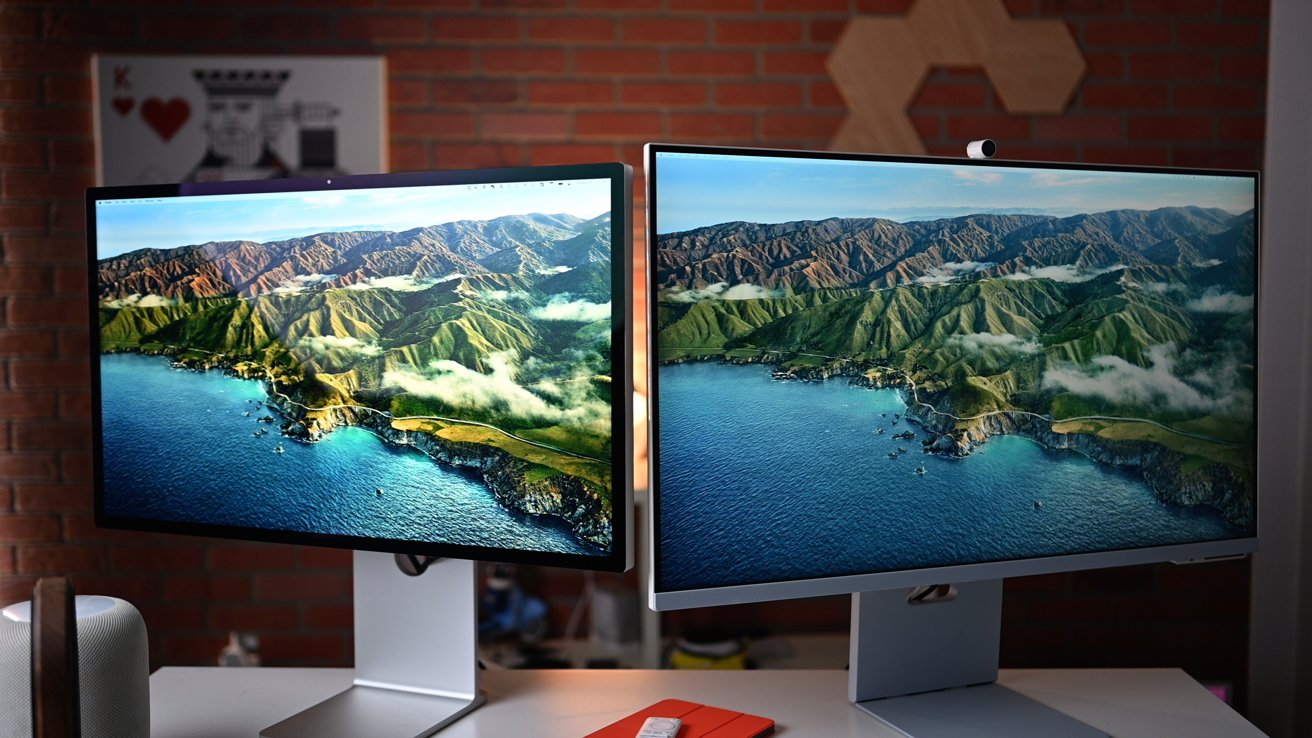
Apple's Studio Display (left), Samsung's Smart Monitor M8 (right)
Apple and Samsung haven't had the best relationship, with the rivals often butting heads regarding product designs. When Samsung introduced the Smart Monitor M8 in January, it seemed that it was another display Samsung made to muscle into territory occupied by the 24-inch iMac.
However, after Apple revealed the Studio Display in March, at around the time Samsung opened up preorders for its screen, it seemed the two competitors suddenly had competing products once again. Both are vaguely similar-looking displays that could be connected to a Mac, and each attempts to offer more than a typical display would to users.
The Samsung Smart Monitor M8 follows the same idea of a thin screen on a very similar-looking bracket. A few minor elements differ, such as the small section to the bottom left that sticks out a bit and the existence of a thin chin on the Samsung, but they're seemingly close on the basic design front.
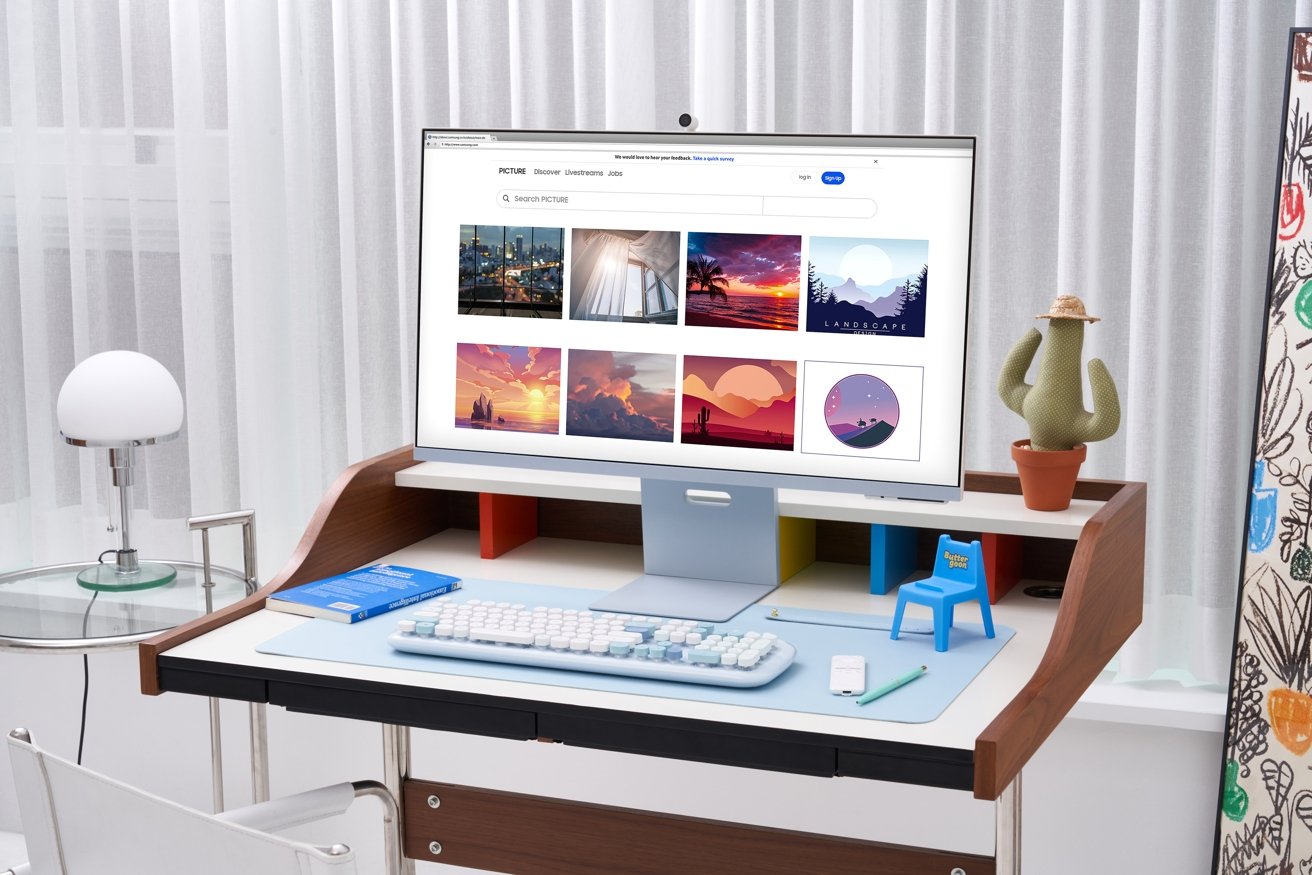
Samsung seemingly took a lot of inspiration from the 24-inch iMac.
Apple's display is physically smaller than Samsung's, primarily due to having a smaller 27-inch screen compared to Samsung's 32-inch version.
The Studio Display is 18.8 inches tall, 24.5-inches wide, and 6.6 inches deep on the tilt-adjustable stand. The M8 is taller at 22.6 inches with its stand, broader at 28 inches, and deeper at 8 inches.
There's also a weight difference but a small one. The M8 weighs 6.7 kilos (14.8 pounds), while the Studio Display is 6.3 kilos (13.9 pounds).
Though, naturally, the Samsung screen is heavier because it's bigger, consider that the weight difference is a mere pound. This makes Apple's display denser, weight-wise.
Then again, we are talking about displays to be kept on a desk. When you're moving them, you'll notice the weight, but not in everyday use.
Apple does squeeze in the higher-resolution 5K screen in its version, with its 5,120 by 2,880 resolution giving it a pixel density of 218ppi. The 3,840 by 2,160 4K screen used by Samsung has a much lower pixel density of 138ppi.
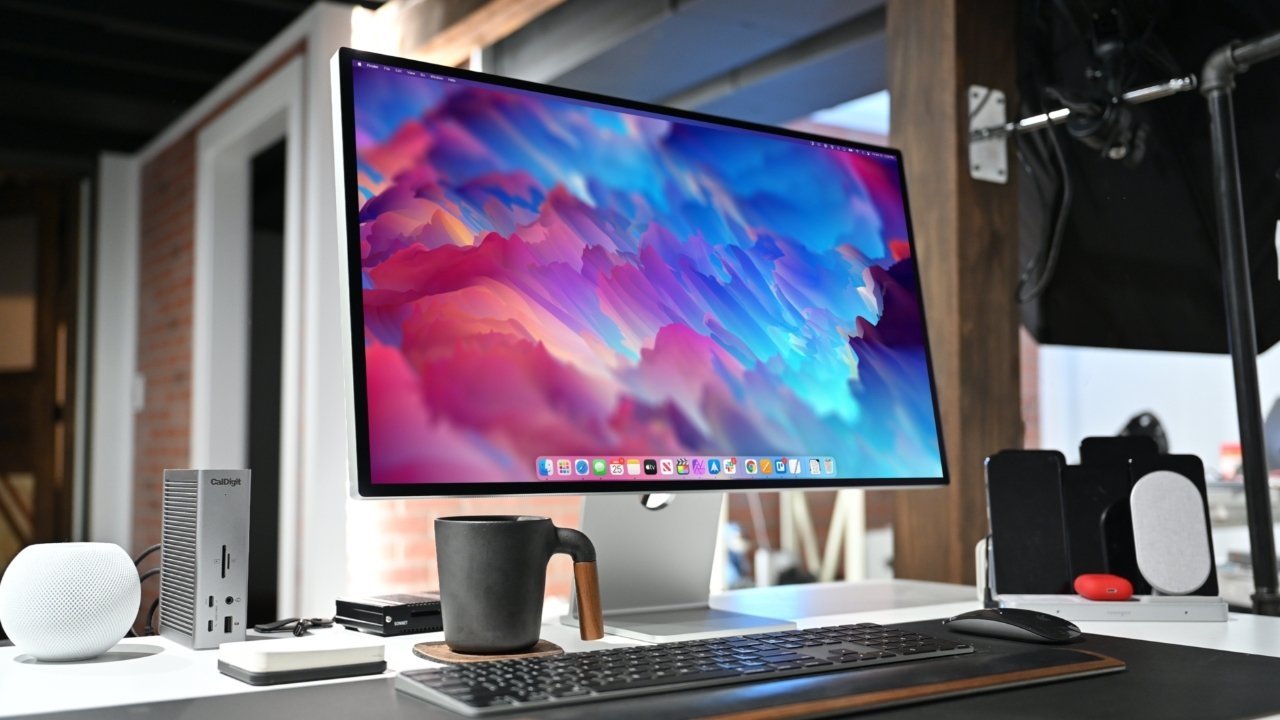
Apple's Studio Display has a far higher 5K resolution than Samsung's 4K screen.
Also in Apple's court is the brightness, with its 600 nits beating Samsung's 400 nits. Both also use an LED backlighting system rather than mini LED but still offer HDR capabilities.
In terms of color representation, the Studio Display has Wide Color (P3) support, with it offering a variety of reference modes to help creatives produce video and still images. Samsung's screen has 99% coverage of sRGB and can display 1.07 billion colors.
Both displays are limited to a maximum refresh rate of 60Hz, though Apple does slip in True Tone support as an extra feature.
The Studio Display has just four connections on the back, with the Thunderbolt 3 intended to be connected to the host Mac, while three USB-C ports handle peripherals.
This seems low, but it's slightly more than Samsung's selection. On the M8, there's one micro HDMI for video, one USB-C intended for an upstream connection and video, and one more for the downstream.
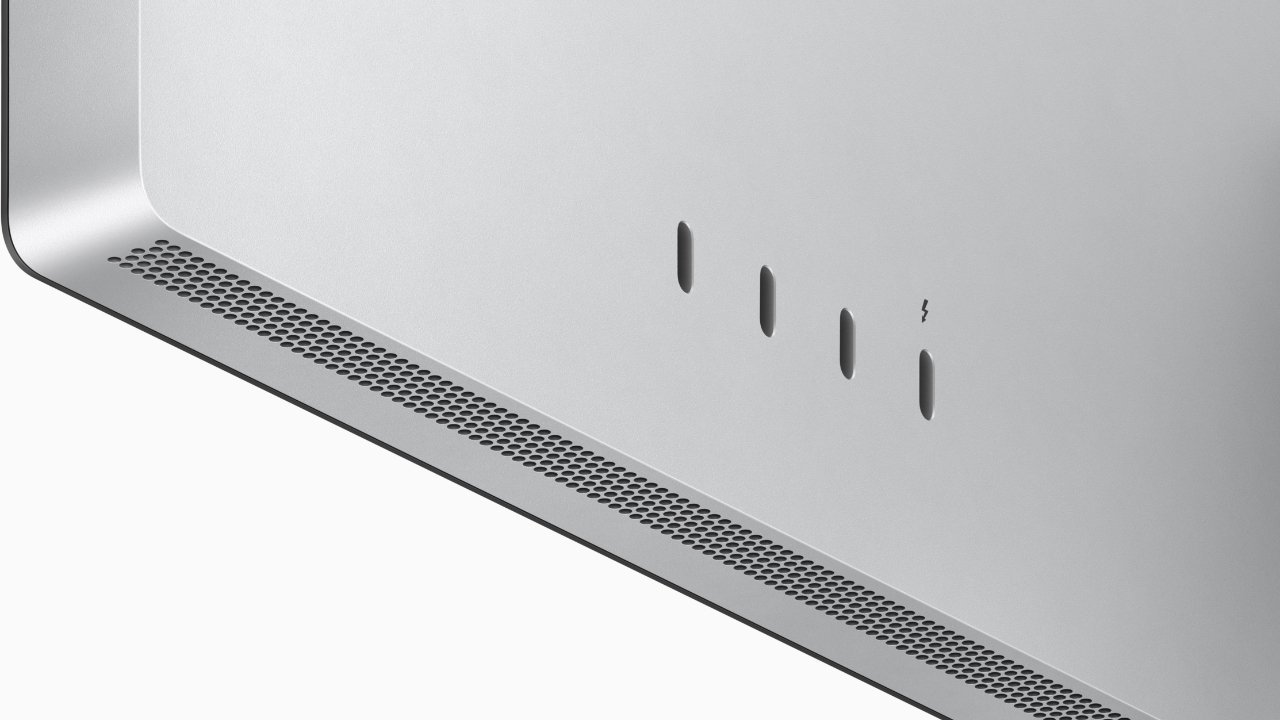
The Studio Display has just four ports, but Samsung's Smart Monitor M8 has only three.
There's also a limitation at play if you intend to use the monitors to recharge connected notebooks. The Studio Display can provide 96W to a host, while the M8 can only manage 65W.
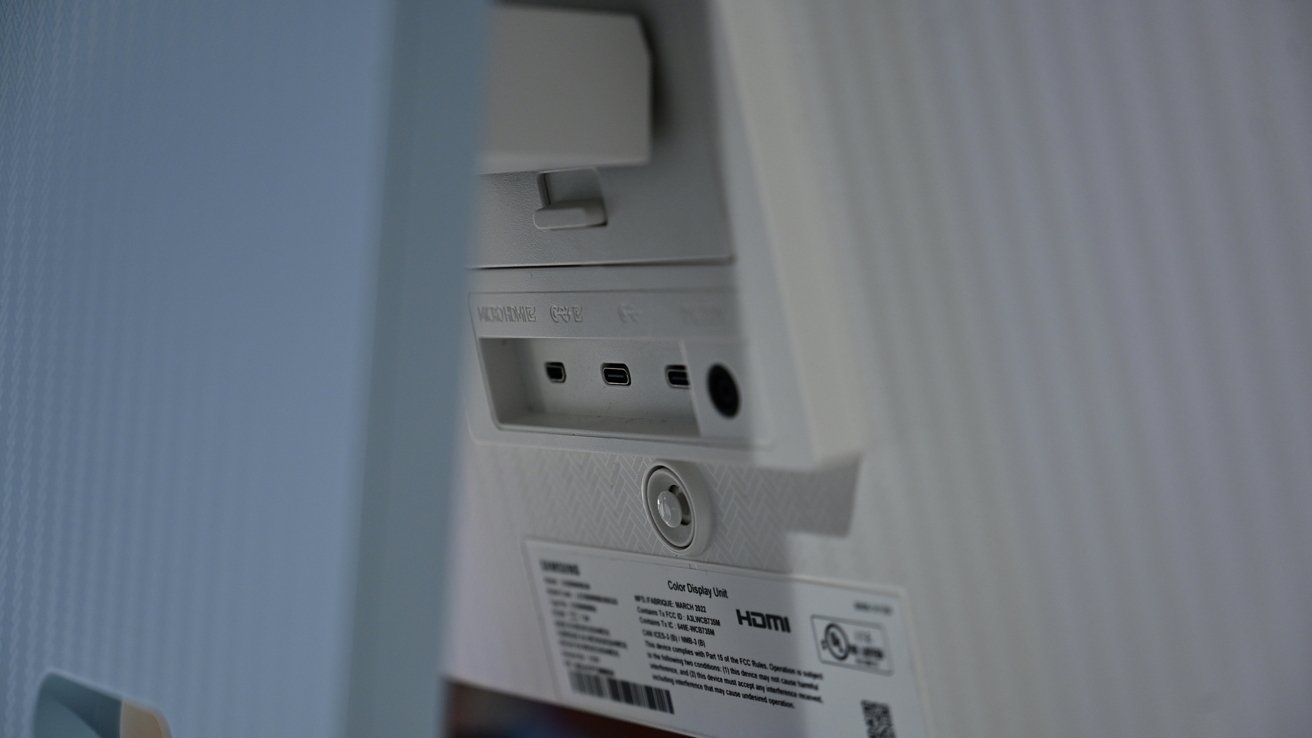
The ports on the M8
The more considerable connectivity element is wireless, as the M8 includes Wi-Fi 5 support and Bluetooth 4.2. This isn't stellar, but it does enable the display to connect to the Internet and other hardware.
This includes AirPlay support so that you can use it as a display for your iPhone or iPad. It also enables smart home connectivity, acting as a SmartThings Hub for supporting devices.
Apple's Studio Display doesn't do this, or any wireless networking. But, since you could use AirPlay to Mac, mirroring is available if you've connected up a Mac. It's not an independent feature.
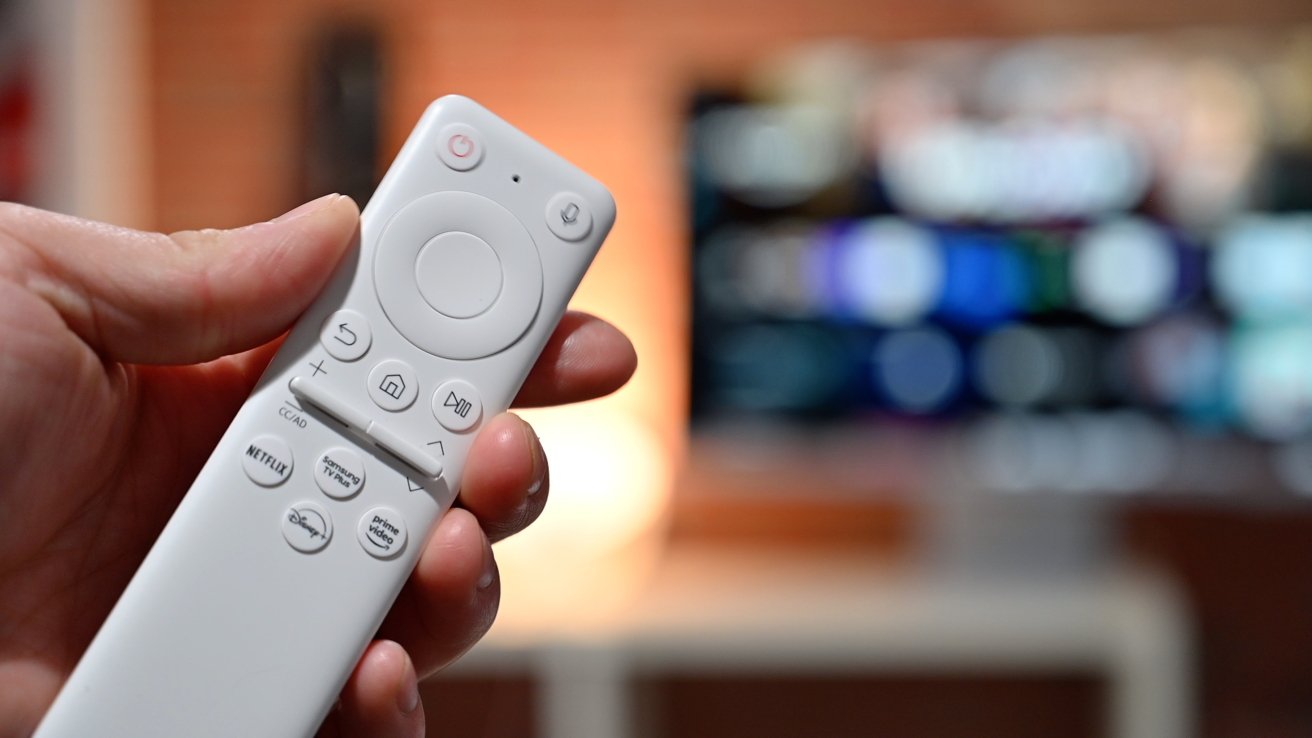
The included M8 remote
In short, it can function as a smart TV.
Running on Tizen, the M8 can run many apps over its Wi-Fi connection. This includes a variety of smart TV apps, including Samsung TV Plus, Netflix, Prime Instant Video, Disney Plus, and Apple TV+.
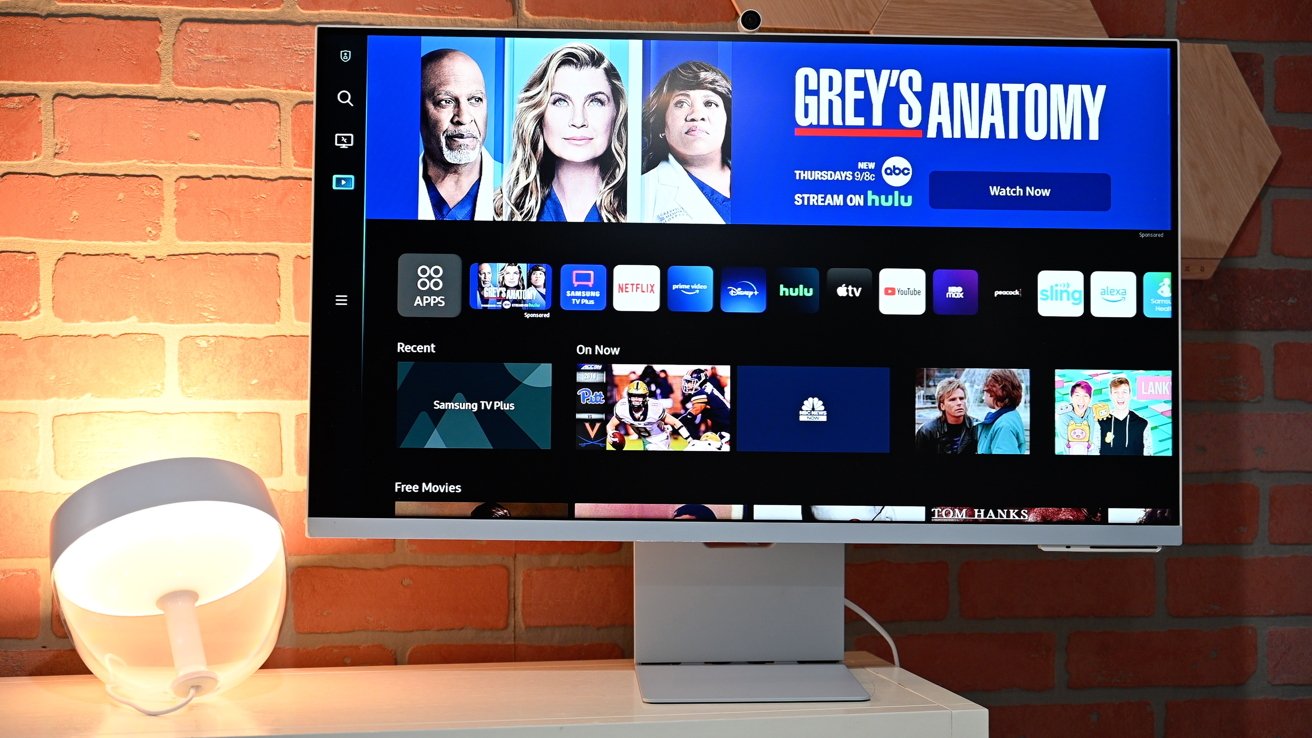
Smart TV apps
This makes the M8 a great option for people who want a display to perform double duty as a TV and monitor. This is especially handy in cases like a child's bedroom, where space or funds may be limited.
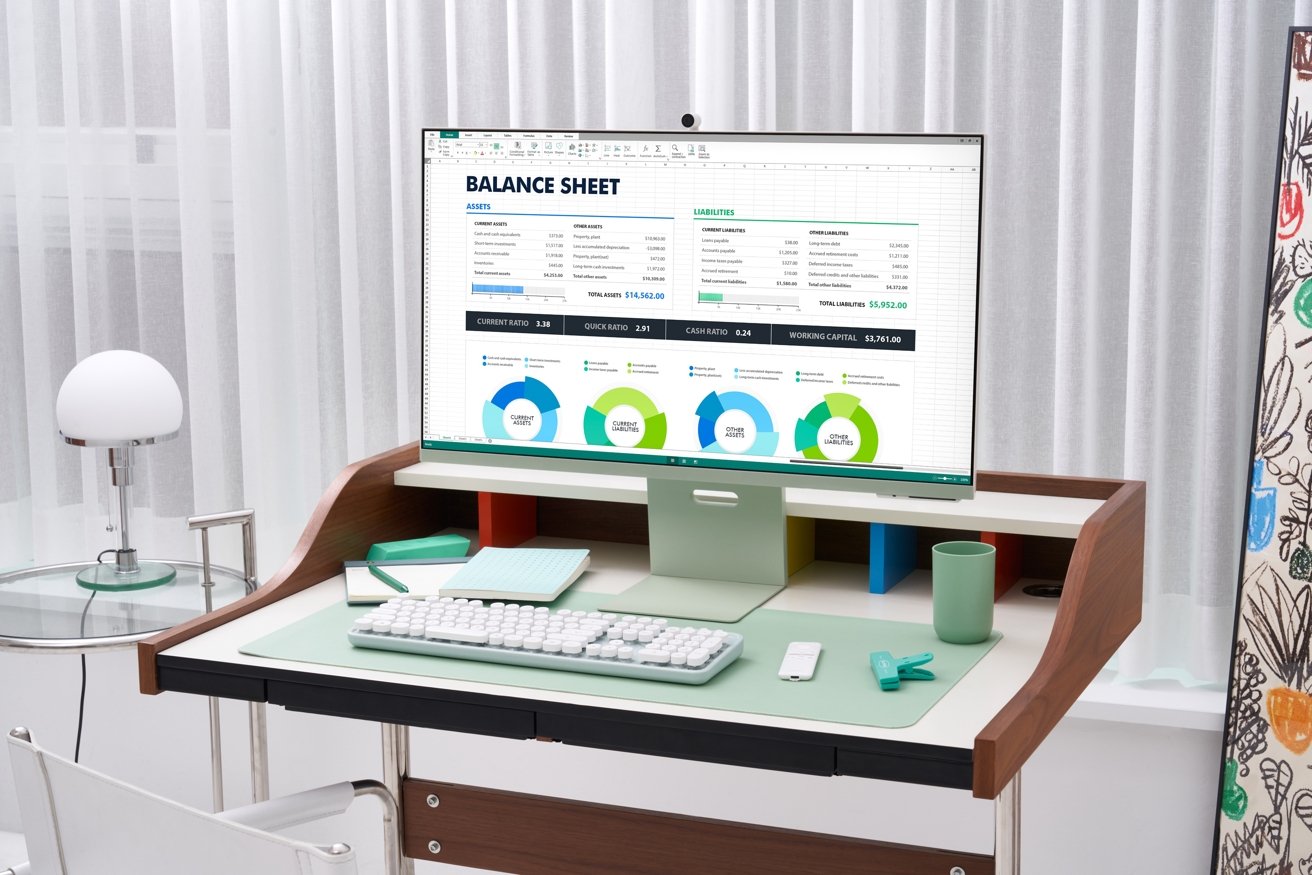
Using a Bluetooth keyboard, mouse, and Microsoft 365, you could use Samsung's M8 without a host computer for work purposes.
Handily, Samsung does include a remote control as part of the package, so users could lounge from the other side of the room as they would for a television.
Of course, Samsung takes this concept a stage further in that it isn't limited to running regular smart TV apps. Instead, Samsung believes it can be used as a standalone workstation without needing a separate PC or Mac nearby.
Using Workmode, the M8 can connect to a remote computer and run Microsoft 365 apps in the cloud when paired with suitable peripherals. Then there's the ability to use Samsung DeX if you have a Samsung smartphone supporting it or AirPlay 2 for working with iPhones and iPads as a larger screen.

Studio Display camera sample
Samsung does offer a camera but in a different way. Instead of embedding a camera into the bezel, it includes the wireless SlimFit Cam, designed to be attached to the back of the top of the display using pogo pins.

M8 camera sample
Sticking out of the top, the SlimFit Cam offers a 1080p image at 30fps. It also has a Face Tracking feature to center the view on the user's face and Auto Zoom to zoom in on the face when they are speaking.
Though it can be used with a host computer, the SlimFit Cam can also be used with onboard video conferencing apps, including Google Duo.
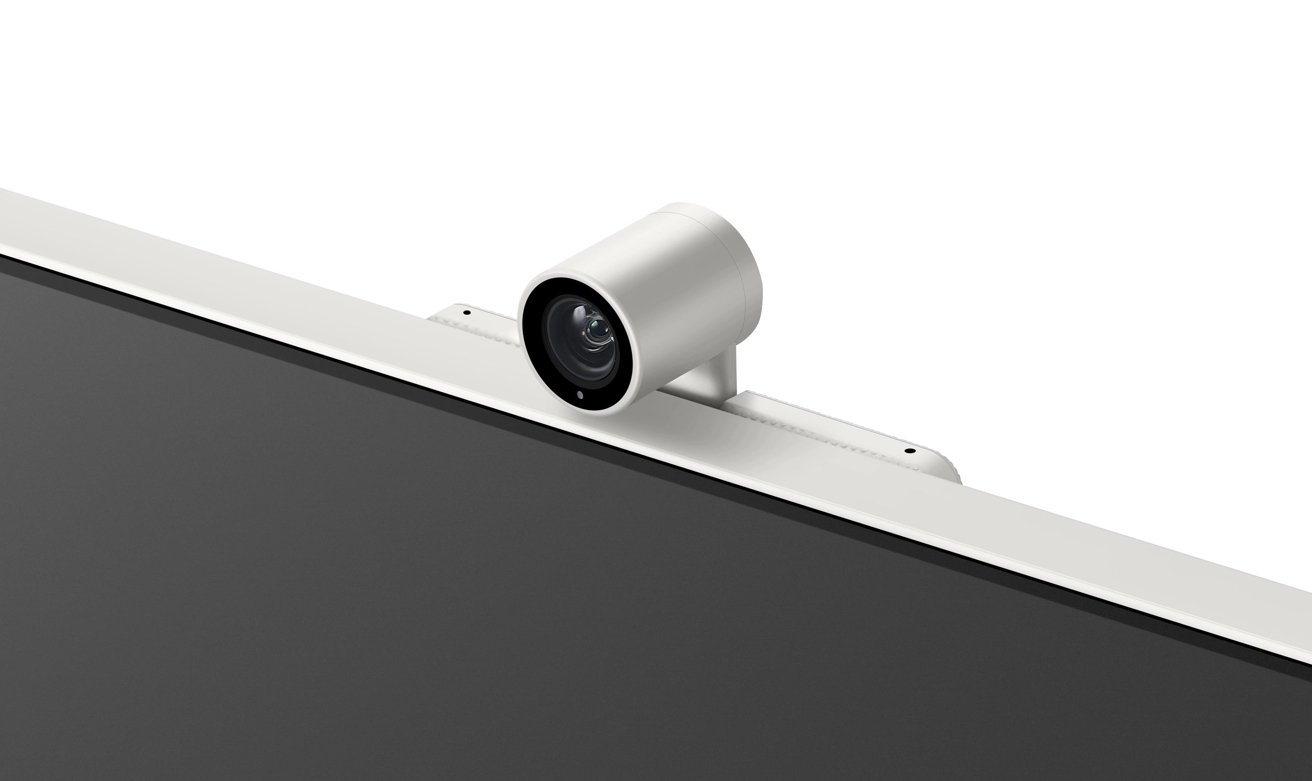
Samsung's SlimFit Cam attaches to the back of the monitor.
Both monitors offer microphone support, with Samsung including a high-sensitivity far-field voice mic, while Apple employs a "studio-quality three-mic array with high signal-to-noise ratio and directional beamforming."
Naturally, there's support for each company's virtual assistant, with Apple's "Hey Siri" usable with a connected Mac. Bixby and Alexa is supported by the M8, though it can do so on its own without needing a host device connected to it.
For audio, Apple includes six speakers with force-canceling woofers in the Studio Display, complete with wide stereo sound and support for Spatial Audio when listening to Dolby Atmos content.
Samsung opts for a 2.2CH setup of 5W stereo speakers with a tweeter. It also has Adaptive Sound+, a system for automatically adjusting the audio based on the type of content and noise levels within the user's environment.
Opting for the standard tilt-adjustable stand or the VESA mount adapter doesn't change the price, but going for the tilt- and height-adjustable stand adds $400. At the highest, you could be paying $2,299 for a Studio Display with the height-adjustable stand and the Nano-texture glass.
Samsung sells the Smart Monitor M8 for $699.99 to $729.99.
While Apple only has the Studio Display in its usual aluminum attire, Samsung borrowed the idea of color options from the 24-inch iMac. You can get the M8 in four colorways: Warm White, Sunset Pink, Daylight Blue, and Spring Green.
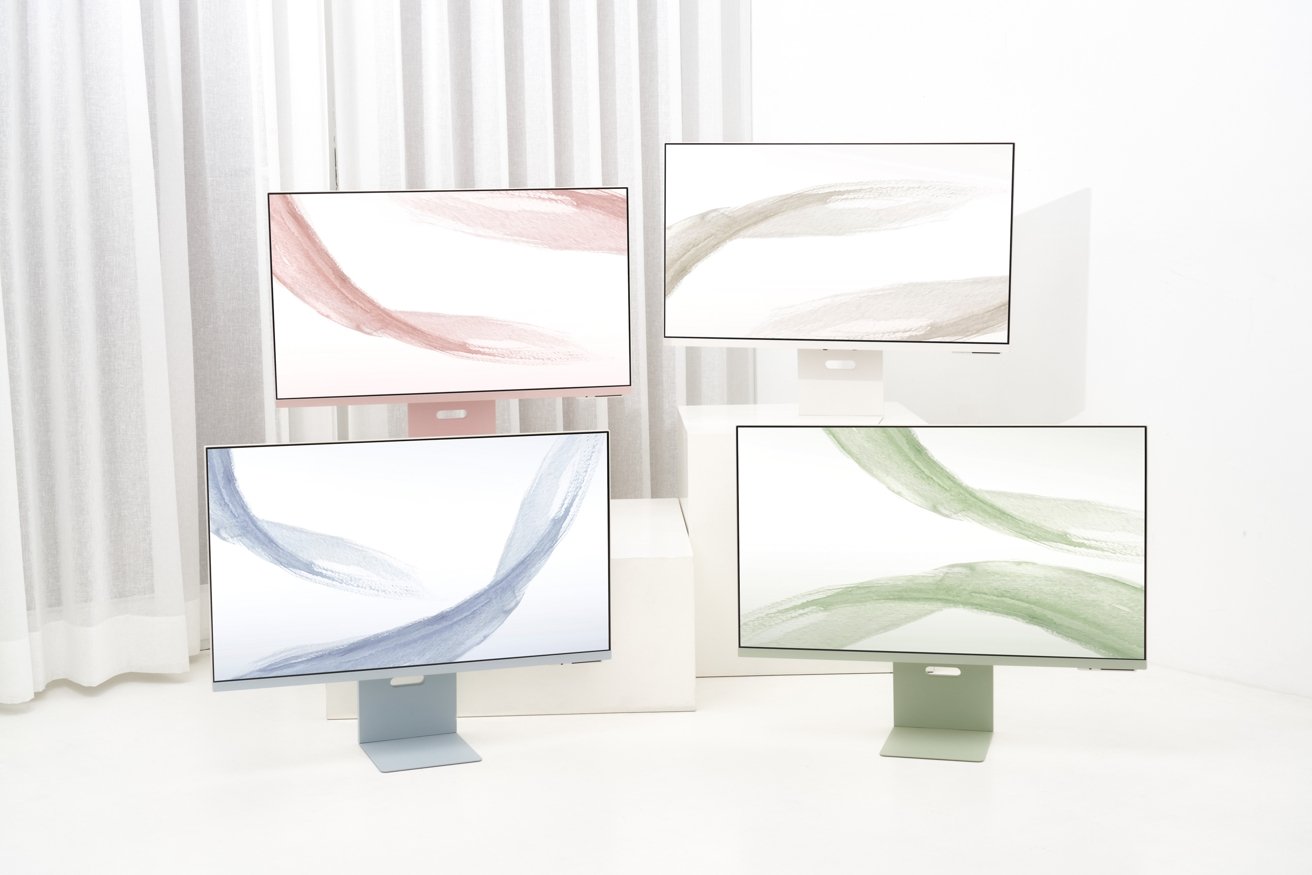
Samsung offers a choice of colors for the Smart Monitor M8. You have only one option for the Apple Studio Display.
Samsung is offering the Smart Monitor M8 as more than just a monitor. It is a fully-functioning smart TV that provides all of the benefits without needing a host computer connected to it all the time.
In cramped living locations, like a small apartment or a child's bedroom, it's not too hard to imagine the M8 handling both television and monitor duties, and without too much hassle. Yes, you can use the Apple Studio Display to watch videos or other content, but you still need to connect things up to it.
Then there's the price, in that you could easily buy two Smart Monitor M8 units for the same as one Apple Studio Display, and still have money left over for cables. That is a huge thing in Samsung's favor.
That's not to say there isn't an audience for Apple's screen, as the brand-loyal and those who care about high resolution and picture quality will err towards the pricier option.
For everyone else, Samsung brings to the table a very compelling argument to go with the Smart Monitor M8 instead.
On the Apple Studio Display side, AppleInsider readers can save $50 on AppleCare for the monitor at Apple Authorized Reseller Adorama. To activate the promotion, you must shop through this cost-saving activation link and enter promo code APINSIDER during checkout. Step-by-step activation instructions can be found on this help page.
Want to see how the offer stacks up? Comparing prices across leading Apple resellers is easy in our Apple Display Price Guide.
Read on AppleInsider

Apple's Studio Display (left), Samsung's Smart Monitor M8 (right)
Apple and Samsung haven't had the best relationship, with the rivals often butting heads regarding product designs. When Samsung introduced the Smart Monitor M8 in January, it seemed that it was another display Samsung made to muscle into territory occupied by the 24-inch iMac.
However, after Apple revealed the Studio Display in March, at around the time Samsung opened up preorders for its screen, it seemed the two competitors suddenly had competing products once again. Both are vaguely similar-looking displays that could be connected to a Mac, and each attempts to offer more than a typical display would to users.
Specifications
| Specifications | Apple Studio Display | Samsung Smart Monitor M8 |
|---|---|---|
| Size (inches) | 27 | 32 |
| Resolution (pixels) | 5120 by 2880 | 3840 by 2160 |
| Color range | P3 | 99% sRGB |
| Backlighting | LED | LED |
| HDR | None | HDR 10+ |
| Peak brightness | 600 nits | 400 nits |
| Refesh Rate | 60Hz | 60Hz |
| True Tone | Yes | No |
| Webcam | 12MP ultra-wide | 1080p detachable SlimFit camera |
| Ports | 1xThunderbolt 3 3xUSB-C | 1xmicro HDMI 1xUSB Type-C Up, 1xUSB Type-C Down |
| Wireless Connectivity | None | Wi-Fi 5, Bluetooth 4.2 |
| Audio | 6-speaker system | 2x5W with tweeter |
| Microphone | Yes, array of three | Far Field Voice microphone |
| Nano-texture | Yes, Optional | No |
| Remote Control | No | Yes |
| Stand options | tilt, tilt + height, VESA | Tilt and Height |
| Other Features | Center Stage, "Hey Siri" support (Mac), 96W host charging | Smart TV functionality, Video conferencing, Workspace cloud services, SmartThings Hub, AirPlay support, 65W USB-C charging |
| Price | $1,599 | $729.99 |
Samsung Smart Monitor M8 vs Apple Studio Display: Design and Dimensions
Since its launch, the Apple Studio Display has been likened to an iMac, consisting of a relatively thin panel on a relatively simple L-shaped bracket. It's a well-known and well-loved aesthetic and one that Samsung appears to borrow for its display.The Samsung Smart Monitor M8 follows the same idea of a thin screen on a very similar-looking bracket. A few minor elements differ, such as the small section to the bottom left that sticks out a bit and the existence of a thin chin on the Samsung, but they're seemingly close on the basic design front.

Samsung seemingly took a lot of inspiration from the 24-inch iMac.
Apple's display is physically smaller than Samsung's, primarily due to having a smaller 27-inch screen compared to Samsung's 32-inch version.
The Studio Display is 18.8 inches tall, 24.5-inches wide, and 6.6 inches deep on the tilt-adjustable stand. The M8 is taller at 22.6 inches with its stand, broader at 28 inches, and deeper at 8 inches.
There's also a weight difference but a small one. The M8 weighs 6.7 kilos (14.8 pounds), while the Studio Display is 6.3 kilos (13.9 pounds).
Though, naturally, the Samsung screen is heavier because it's bigger, consider that the weight difference is a mere pound. This makes Apple's display denser, weight-wise.
Then again, we are talking about displays to be kept on a desk. When you're moving them, you'll notice the weight, but not in everyday use.
Samsung Smart Monitor M8 vs Apple Studio Display: The Screen
The obvious difference is the already-mentioned size, a 27-inch screen on Apple's side against 32-inches on Samsung's. These are both good-sized monitors for desk use, with the 32-inch lending itself to more further-away viewing for content consumption.Apple does squeeze in the higher-resolution 5K screen in its version, with its 5,120 by 2,880 resolution giving it a pixel density of 218ppi. The 3,840 by 2,160 4K screen used by Samsung has a much lower pixel density of 138ppi.

Apple's Studio Display has a far higher 5K resolution than Samsung's 4K screen.
Also in Apple's court is the brightness, with its 600 nits beating Samsung's 400 nits. Both also use an LED backlighting system rather than mini LED but still offer HDR capabilities.
In terms of color representation, the Studio Display has Wide Color (P3) support, with it offering a variety of reference modes to help creatives produce video and still images. Samsung's screen has 99% coverage of sRGB and can display 1.07 billion colors.
Both displays are limited to a maximum refresh rate of 60Hz, though Apple does slip in True Tone support as an extra feature.
Samsung Smart Monitor M8 vs Apple Studio Display: Connectivity
Apple is not known for offering a wide array of physical connection options in its products. Still, weirdly, Samsung's adoption of Apple's minimalist approach may have given Apple a slight advantage.The Studio Display has just four connections on the back, with the Thunderbolt 3 intended to be connected to the host Mac, while three USB-C ports handle peripherals.
This seems low, but it's slightly more than Samsung's selection. On the M8, there's one micro HDMI for video, one USB-C intended for an upstream connection and video, and one more for the downstream.

The Studio Display has just four ports, but Samsung's Smart Monitor M8 has only three.
There's also a limitation at play if you intend to use the monitors to recharge connected notebooks. The Studio Display can provide 96W to a host, while the M8 can only manage 65W.

The ports on the M8
The more considerable connectivity element is wireless, as the M8 includes Wi-Fi 5 support and Bluetooth 4.2. This isn't stellar, but it does enable the display to connect to the Internet and other hardware.
This includes AirPlay support so that you can use it as a display for your iPhone or iPad. It also enables smart home connectivity, acting as a SmartThings Hub for supporting devices.
Apple's Studio Display doesn't do this, or any wireless networking. But, since you could use AirPlay to Mac, mirroring is available if you've connected up a Mac. It's not an independent feature.
Samsung Smart Monitor M8 vs Apple Studio Display: Smart TV and Smart Working
The aforementioned wireless connectivity is essential for another significant element of the M8. The "Smart" part of the Smart Monitor's name refers to how it offers various services without needing to be hooked up to a host device, like a Mac or PC.
The included M8 remote
In short, it can function as a smart TV.
Running on Tizen, the M8 can run many apps over its Wi-Fi connection. This includes a variety of smart TV apps, including Samsung TV Plus, Netflix, Prime Instant Video, Disney Plus, and Apple TV+.

Smart TV apps
This makes the M8 a great option for people who want a display to perform double duty as a TV and monitor. This is especially handy in cases like a child's bedroom, where space or funds may be limited.

Using a Bluetooth keyboard, mouse, and Microsoft 365, you could use Samsung's M8 without a host computer for work purposes.
Handily, Samsung does include a remote control as part of the package, so users could lounge from the other side of the room as they would for a television.
Of course, Samsung takes this concept a stage further in that it isn't limited to running regular smart TV apps. Instead, Samsung believes it can be used as a standalone workstation without needing a separate PC or Mac nearby.
Using Workmode, the M8 can connect to a remote computer and run Microsoft 365 apps in the cloud when paired with suitable peripherals. Then there's the ability to use Samsung DeX if you have a Samsung smartphone supporting it or AirPlay 2 for working with iPhones and iPads as a larger screen.
Samsung Smart Monitor M8 vs Apple Studio Display: Cameras and Other Features
Apple includes a 12-megapixel Ultra-Wide camera in its Studio Display, embedded in the top of the bezel. With support for Center Stage, the 122-degree field of view can be cropped down so that only the person involved with a FaceTime call can be seen, not the rest of the room.
Studio Display camera sample
Samsung does offer a camera but in a different way. Instead of embedding a camera into the bezel, it includes the wireless SlimFit Cam, designed to be attached to the back of the top of the display using pogo pins.

M8 camera sample
Sticking out of the top, the SlimFit Cam offers a 1080p image at 30fps. It also has a Face Tracking feature to center the view on the user's face and Auto Zoom to zoom in on the face when they are speaking.
Though it can be used with a host computer, the SlimFit Cam can also be used with onboard video conferencing apps, including Google Duo.

Samsung's SlimFit Cam attaches to the back of the monitor.
Both monitors offer microphone support, with Samsung including a high-sensitivity far-field voice mic, while Apple employs a "studio-quality three-mic array with high signal-to-noise ratio and directional beamforming."
Naturally, there's support for each company's virtual assistant, with Apple's "Hey Siri" usable with a connected Mac. Bixby and Alexa is supported by the M8, though it can do so on its own without needing a host device connected to it.
For audio, Apple includes six speakers with force-canceling woofers in the Studio Display, complete with wide stereo sound and support for Spatial Audio when listening to Dolby Atmos content.
Samsung opts for a 2.2CH setup of 5W stereo speakers with a tweeter. It also has Adaptive Sound+, a system for automatically adjusting the audio based on the type of content and noise levels within the user's environment.
Samsung Smart Monitor M8 vs Apple Studio Display: Pricing
Apple sells the Studio Display starting from $1,599. Adding Nano-texture glass, which provides an anti-reflective coating to the display, costs $300.Opting for the standard tilt-adjustable stand or the VESA mount adapter doesn't change the price, but going for the tilt- and height-adjustable stand adds $400. At the highest, you could be paying $2,299 for a Studio Display with the height-adjustable stand and the Nano-texture glass.
Samsung sells the Smart Monitor M8 for $699.99 to $729.99.
While Apple only has the Studio Display in its usual aluminum attire, Samsung borrowed the idea of color options from the 24-inch iMac. You can get the M8 in four colorways: Warm White, Sunset Pink, Daylight Blue, and Spring Green.
All-arounder vs Premium
On one hand, you have Apple's Studio Display with its superior resolution, notable styling, color representation, and the brand's premium value. On the other, Samsung provides a larger screen with a lower resolution, one that isn't quite as bright, and copies the iMac range a bit too much.
Samsung offers a choice of colors for the Smart Monitor M8. You have only one option for the Apple Studio Display.
Samsung is offering the Smart Monitor M8 as more than just a monitor. It is a fully-functioning smart TV that provides all of the benefits without needing a host computer connected to it all the time.
In cramped living locations, like a small apartment or a child's bedroom, it's not too hard to imagine the M8 handling both television and monitor duties, and without too much hassle. Yes, you can use the Apple Studio Display to watch videos or other content, but you still need to connect things up to it.
Then there's the price, in that you could easily buy two Smart Monitor M8 units for the same as one Apple Studio Display, and still have money left over for cables. That is a huge thing in Samsung's favor.
That's not to say there isn't an audience for Apple's screen, as the brand-loyal and those who care about high resolution and picture quality will err towards the pricier option.
For everyone else, Samsung brings to the table a very compelling argument to go with the Smart Monitor M8 instead.
Where to Buy
The Samsung M8 display starts at $699.99 and is available for purchase at Samsung.com and at B&H Photo Video.On the Apple Studio Display side, AppleInsider readers can save $50 on AppleCare for the monitor at Apple Authorized Reseller Adorama. To activate the promotion, you must shop through this cost-saving activation link and enter promo code APINSIDER during checkout. Step-by-step activation instructions can be found on this help page.
Want to see how the offer stacks up? Comparing prices across leading Apple resellers is easy in our Apple Display Price Guide.
Read on AppleInsider


Comments
If it’s a smart TV I’m sure it’s loaded with garbage Android crap just like my Sony TV. The Studio Display is loaded with Apple things which are better for Macs than Android garbage. Not sure why AI continues to review stuff that isn’t from Apple.
The M8 vs one of LG's 27" 4K USB-C monitor is a more apt apples-to-apples comparison.
anyway, I think for my next display I will go the Dell u2723QE which is similarly priced to the M8, stick the Dell magnetic speakers on it and if I wanted TV, stick a Google Chromecast or an old Apple TV in one of its many ports. It has a similar 400 nit HDR spec but an IPS wide angle viewing IPS black panel with a 2000:1 contrast ratio. it even has a 32 inch big brother for half the price of the studio display.
I would never send my work screen time into any “smart” app loaded, independently connected device, be it tizen or android powered one.
I use airplay eventually for entertainment.
Taking screen shot, contrasting it into b&w for text reading and making it a light gif/png, sending it header-less out, hidden in a lil’ packet thru mandatory “system services” connection in such “smart” viewing device is matter of milliseconds. It can even be done on firmware level.
Once I’ve been using android powered projector. It began offering me the same TV series in play store apps, based on my Mac VLC video out.. think about that!
You can't always get what you want
But if you try sometime, you find
You get what you need
This Samsung product is not going to put a dent in Studio Display sales but Samsung will probably have to compete against lower-cost 4K smart TVs that can also serve as decent enough computer monitors, or secondary computer monitors, that are also viable candidates for kids room and dorm room applications, as are inexpensive 4K “dumb” TVs or monitors with an attached Apple TV if the camera feature isn’t necessary.
I also find I keep my settings at the lowest brightness that works for the environment, and never need full brightness for both circadian and sustainability reasons and remember fondly my 30" cinema despite its 'softer' contrast ratio which I enjoyed along with the beauty of aqua at the time...
A couple of months ago I was looking for a ~28" 4k monitor. I found one at a good price, a Samsung, not this model. Now I'd had bad luck with Samsung products in years past but I figured that maybe it was time to give them another shot. Well no, it was trash. Video kept dropping out, losing synch, just scrambling. The only way to get it to come back was to unplug power, plug it back in, and start it up again. USUALLY that would bring it back. I tried different video cables, different USB-C plug on the MAC, all sorts of things to no avail it just kept getting worse and worse. After two days I gave up and returned it. Instead I got an Asus monitor with similar specs. It was about the same price but it's been stone reliable. Samsung is still making the same cheap crap they did in years past.
So in for this review you have an Apple display that I would assume was a good build quality and would be pretty reliable or a Samsung that I would not trust at all.
AppleInsider should do reviews, they are popping all the bubbles of the shortsighted people had a problem with the Studio Display upon release, they are showing you really do git what your pay for, the Apple monitor is the best you can buy for your Mac under 2000 dollars.
While the Samsung M8 is chock full of interesting and potentially useful features, its display quality was extremely disappointing.
We initially went with the M8 because we wanted something larger than Apple’s 27" display. The Samsung M8 has poor viewing angles (it’s a VA type display and not IPS) and was also dim. The construction of the Samsung M8 is cheap. Nearly all of it is plastic and it felt flimsy. Since the Apple display is too small for our needs we went with a 34” ultrawide LG and it is a night and day difference in terms of image quality.